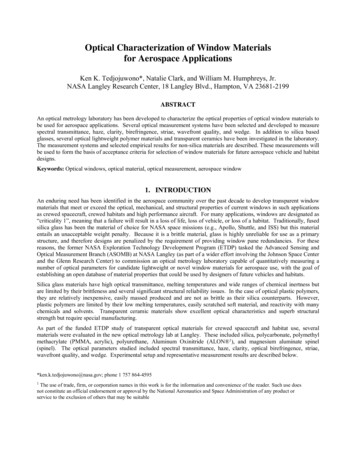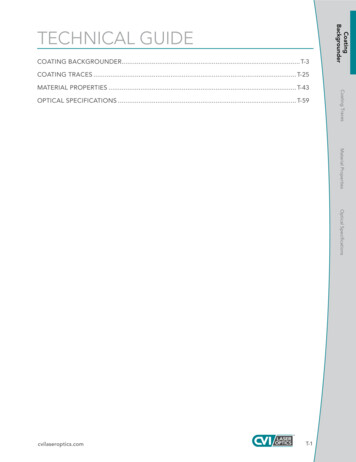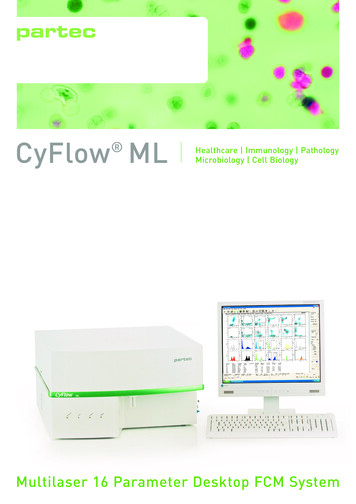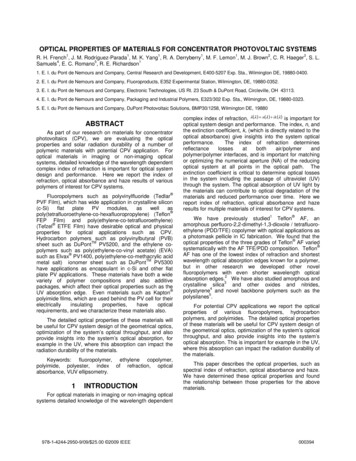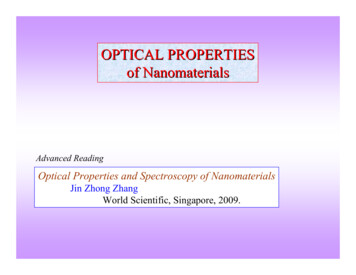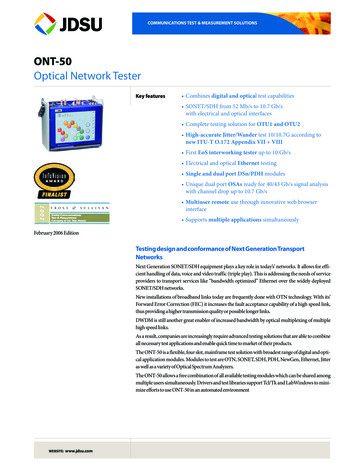
Transcription
HomeSearchCollectionsJournalsAboutContact usMy IOPscienceRoadmap of optical communicationsThis content has been downloaded from IOPscience. Please scroll down to see the full text.2016 J. Opt. 18 3002)View the table of contents for this issue, or go to the journal homepage for moreDownload details:IP Address: 128.111.50.109This content was downloaded on 18/01/2017 at 00:08Please note that terms and conditions apply.You may also be interested in:Gallium nitride LEDs for multi-gigabit-per-second visible light data communicationsSujan Rajbhandari, Jonathan J D McKendry, Johannes Herrnsdorf et al.Exabit optical communication explored using 3M schemeMasataka NakazawaRoadmap on silicon photonicsDavid Thomson, Aaron Zilkie, John E Bowers et al.Optical technologies for data communication in large parallel systemsM B Ritter, Y Vlasov, J A Kash et al.Application of a digital non-linear compensation algorithm for evaluating the performance ofroot-raised-cosine pulses in 112 Gbit s-1 DP-QPSK transmissionRameez Asif, Muhammad Usman, Chien-Yu Lin et al.Soliton communication lines based on spectrally efficient modulation formatsO V Yushko and A A RedyukAdvances and Perspectives in Photonic Technology Research in the European Information SocietyTechnologies ProgrammeDidier Erasme, Christophe Minot, Filip Ohman et al.Fiber Nonlinearity Post-Compensation by Optical Phase Conjugation for 40Gb/s CO-OFDM SystemsQiao Yao-Jun, Liu Xue-Jun and Ji Yue-FengInvestigation of phosphor-LED lamp for real-time half-duplex wireless VLC systemChien-Hung Yeh, Chi-Wai Chow, Hsing-Yu Chen et al.
Journal of OpticsJ. Opt. 18 (2016) 063002 map of optical communicationsErik Agrell1,18, Magnus Karlsson2,18, A R Chraplyvy3, David J Richardson4,Peter M Krummrich5, Peter Winzer3, Kim Roberts6, Johannes Karl Fischer7,Seb J Savory8, Benjamin J Eggleton9, Marco Secondini10,Frank R Kschischang11, Andrew Lord12, Josep Prat13, Ioannis Tomkos14,John E Bowers15, Sudha Srinivasan15, Maïté Brandt-Pearce16 andNicolas Gisin171Department of Signals and Systems, Chalmers University of Technology, SE-412 96 Gothenburg, SwedenPhotonics Laboratory, Department of Microtechnology and Nanoscience, Chalmers University ofTechnology, SE-412 96 Gothenburg, Sweden3Bell Labs, Nokia, 791 Holmdel-Keyport Road, Holmdel, NJ 07733, USA4Optoelectronics Research Centre, Faculty of Physical Sciences and Engineering, University ofSouthampton, Southampton, SO17 1BJ, UK5Technische Universität Dortmund, Friedrich-Wöhler-Weg 4, D-44227 Dortmund, Germany6Ciena Corporation, 3500 Carling Ave., Ottawa, Ontario, Canada7Department of Photonic Networks and Systems, Fraunhofer Institute for Telecommunications HeinrichHertz-Institute, Einsteinufer 37, D-10587 Berlin, Germany8Electrical Engineering Division, Engineering Department, University of Cambridge, 9 J J ThomsonAvenue, Cambridge CB3 0FA, UK9Centre for Ultrahigh Bandwidth Devices for Optical Systems (CUDOS), Institute of Photonics and OpticalScience (IPOS), School of Physics, University of Sydney, NSW 2006, Australia10TeCIP Institute, Scuola Superiore Sant’Anna, I-56124 Pisa, Italy11Department of Electrical and Computer Engineering, University of Toronto, Toronto, Canada12British Telecom, pp. B29/OP8, Polaris House, Adastral Park, Martlesham Heath, Ipswich, Suffolk, UK13Signal Theory and Communications Department, Universitat Politecnica de Catalunya, E-08034Barcelona, Spain14Athens Information Technology Center, Athens, 15125 Marousi, Greece15Department of Electrical and Computer Engineering, University of California, Santa Barbara, California93106, USA16Charles L. Brown Department of Electrical and Computer Engineering, University of Virginia,Charlottesville, Virginia 22904 USA17Group of Applied Physics, University of Geneva, CH-1211 Geneva 4, Switzerland2E-mail: agrell@chalmers.se and magnus.karlsson@chalmers.seReceived 14 September 2015, revised 15 December 2015Accepted for publication 15 December 2015Published 3 May 2016AbstractLightwave communications is a necessity for the information age. Optical links provide enormousbandwidth, and the optical fiber is the only medium that can meet the modern society's needs fortransporting massive amounts of data over long distances. Applications range from global highcapacity networks, which constitute the backbone of the internet, to the massively parallel18Guest editors of the roadmap.Original content from this work may be used under the termsof the Creative Commons Attribution 3.0 licence. Anyfurther distribution of this work must maintain attribution to the author(s) andthe title of the work, journal citation and DOI.2040-8978/16/063002 40 33.001 2016 IOP Publishing Ltd Printed in the UK
J. Opt. 18 (2016) 063002Roadmapinterconnects that provide data connectivity inside datacenters and supercomputers. Opticalcommunications is a diverse and rapidly changing field, where experts in photonics, communications,electronics, and signal processing work side by side to meet the ever-increasing demands for highercapacity, lower cost, and lower energy consumption, while adapting the system design to novelservices and technologies. Due to the interdisciplinary nature of this rich research field, Journal ofOptics has invited 16 researchers, each a world-leading expert in their respective subfields, tocontribute a section to this invited review article, summarizing their views on state-of-the-art andfuture developments in optical communications.Keywords: optical communication, optical fiber, optical network, signal processing(Some figures may appear in colour only in the online journal)Contents1. Introduction42. History53. Optical fibers for next generation optical networks74. Amplification and regeneration95. Spatial multiplexing116. Coherent transceivers137. Modulation formats158. Digital signal progressing179. Optical signal processing1910. Nonlinear channel modeling and mitigation2111. Forward error correction2312. Long-haul networks2513. Access networks2714. Optical communications for datacenters2915. Optical integration and silicon photonics3116. Optical wireless communications3317. Quantum communication352
J. Opt. 18 (2016) 063002RoadmapTable of acronymsADCanalog-to-digital converterASICAWGNmultiple-input, multiple-outputapplication-specific integrated circuitMIMONFTadditive white Gaussian noiseNLSEnonlinear Schrödinger equationCDCMOSchromatic dispersioncomplementary metal-oxide semiconductorOFDMONUorthogonal frequency-division multiplexingoptical network unitDACDBPdigital-to-analog converterdigital backpropagationOWCPAMoptical wireless communicationpulse amplitude modulationDCdatacenterPDMpolarization-division multiplexingDCFDCNdispersion compensating fiberdatacenter networkPMDPONpolarization-mode dispersionpassive optical networkDDDSFdirect detectiondispersion-shifted fiberPSKQAMphase-shift keyingquadrature amplitude modulationDSPdigital signal processingQCquantum communicationEDFAENOBerbium-doped fiber amplifiereffective number of bitsQKDRFquantum key n multiplexingforward error correctionROADMRSreconfigurable optical add drop multiplexerReed–SolomonFWMfour-wave mixingSDMspace-division multiplexingFMFFSOfew-mode fiberfree space opticalSNRSSMFsignal-to-noise ratiostandard single-mode fiberHPCIMhigh-performance computing infrastructureintensity modulationTDMToRtime-division multiplexingtop of rackLEDlight emitting diodeVCSELvertical-cavity surface emitting laserMCFMDmulticore fibermodal dispersionVLCWDMvisible light communicationwavelength-division multiplexing3nonlinear Fourier transform
J. Opt. 18 (2016) 063002Roadmap1. IntroductionErik Agrell and Magnus KarlssonChalmers University of TechnologyToday’s society relies on fast and reliable exchange ofinformation. Advanced communication systems support theoperation of industries, businesses and banks; vehicles andtransportation systems; household entertainment electronicsand the global flow of news and knowledge. High-qualitytransmission of real-time video reduces the need for energyconsuming transportation of documents and people, therebycontributing to a sustainable environment. Numerous emerging services and applications, for example, medical diagnosis and treatment, traffic safety and guidance and theInternet of things, are waiting around the corner, stretchingthe needs for high-capacity communications even further. Thelong-term trend is illustrated in figure 1, which shows thedramatic growth of global Internet traffic, according to Cisco’s statistics and predictions [1].The information highways that make these servicespossible consist almost exclusively of optical fibers. No otherknown medium can support the massive demands for datarate, reliability and energy efficiency. After pioneeringexperiments in the 1960s and 70s, optical fibers were laiddown for commercial deployment in the 1980s and 90s,replacing the older copper wires and communication satellitesfor long-distance transmission. The race for ever better performance continues and the capacity of a single fiber has beenboosted by several orders of magnitude, from a few Gb/s in1990 to hundreds of Tb/s today, so far more or less keepingup with society’s rapidly growing demands.The tremendous progress in optical communicationsresearch is the fruit of the combined efforts of researchers fromdiverse disciplines. The expertise needed to design a high-performance optical communication system ranges from physics tophotonics and electronics, from communication and signalprocessing algorithms to network technologies. The purpose ofthis roadmap article is to survey the state-of-the-art in opticalcommunications from multiple viewpoints, and envision wherethis rapidly evolving field might progress in the future. Due tothe broad, interdisciplinary character of the research field, thepaper is a joint effort by many researchers, each one being aleading expert in a certain subfield of optical communications.Together we aim to provide a broad overview of optical communications as a whole.The roadmap article can be coarsely divided in fourblocks, covering the optical communications field: hardware,algorithms, networks and emerging technologies. After aninitial historical overview, the first block covers the opticalhardware needed for high-speed, low-loss lightwave transmission. This block consists of four sections, covering in turnoptical fibers, optical amplification, spatial divisionFigure 1. The past and predicted growth of the total Internettraffic [1].multiplexing and coherent transceivers. Then follows theblock on communication and signal processing algorithms,which describes how to efficiently encode digital data ontolightwaves and to recover the information reliably at thereceiver. The five sections in this block cover, respectively,modulation formats, digital signal processing (DSP), opticalsignal processing, nonlinear channel modeling and mitigation and forward error correction (FEC). The third block liftsthe perspective from point-to-point links to networks of manyinterconnected links, where the three sections cover thetechnologies needed in different kinds of networks: longhaul, access and data center networks. In the fourth and lastblock, finally, some emerging technologies are described,which are currently undergoing intense research and maypotentially provide disruptively different solutions to futureoptical communication systems. These technologies areoptical integration and silicon photonics, optical wirelesscommunication (OWC) and quantum communication (QC).AcknowledgmentsWe wish to sincerely thank all coauthors for their contributions and Jarlath McKenna at IOP Publishing for the coordination in putting this roadmap together.4
J. Opt. 18 (2016) 063002Roadmap2. HistoryA R ChraplyvyBell Labs, NokiaThe vision and predictions of Charles Kao and GeorgeHockham in 1966 of ultra-low loss silica glass [2] and the firstdemonstration of 20–dB/km optical fiber loss in 1970 [3]gave birth to the age of optical fiber communications. In 1977the first test signals were sent through a field test system inChicago’s Loop District. Within months the first live telephone traffic was transmitted through multimode fibers byGTE (at 6 Mb/s) and AT&T (at 45 Mb/s) and the first era inthe age of fiber telecommunications began.We are currently in the third major era in the age of fibercommunications. The first era, the era of direct-detection,regenerated systems began in 1977 and lasted about 16 years.Some of the key milestones of that era follow (a complete earlyhistory circa 1983 can be found in a comprehensive reviewpaper by Li [4]). In 1978 the first ‘fiber-to-the-home’ wasdemonstrated as part of Japan’s Hi OVIS project. The use ofmultimode fibers and 850 nm wavelengths in trunk systemswas short-lived because of ever increasing capacity demands.The first 1300-nm systems debuted in 1981 and the transitionto single-mode fibers began with the British Telecom field trialin 1982. The first submarine fiber to carry telephone traffic wasinstalled in 1984. The remainder of the decade witnessed everincreasing commercial bit rates, from 45 Mb/s, to 90, 180,417, and finally AT&T’s FT-G system operating at 1.7 Gb/s.(As an aside, the FT-G system ‘anticipated’ the wavelengthdivision-multiplexing (WDM) revolution by implementingtwo wavelengths around 1550 nm to double the capacity to3.4 Gb/s.) The synchronous optical network rate of 2.5 Gb/swas first introduced in 1991. Of course, results from researchlaboratories around the world far exceeded the performance ofcommercial systems. 2, 4, and 8 Gb/s time-division multiplexing (TDM) rates were demonstrated between 1984 and1986. The first 10 Gb/s experiments occurred in 1988 and16 Gb/s and 20 Gb/s systems experiments were demonstratedin 1989 and 1991, respectively. But by that time it wasbecoming obvious that the days of the first era of opticalcommunications were numbered.The development of practical erbium-doped fiber amplifiers (EDFA) in the late 1980s [5, 6] (section 4) held out thepromise of completely unregenerated long-haul systems andheralded WDM, the next era of optical communications.Unfortunately the existence of optical amplifiers was not sufficient for introduction of large scale WDM at high bit rates.The two existing fiber types in the early 1990s could notsupport large-channel-count WDM at bit rates above 2.5 Gb/s.Standard single-mode fiber (SSMF, ITU G.652) had largechromatic dispersion ( 17 ps/nm/km) in the 1550 nm wavelength region. Consequently, the reach of 10 Gb/s signals wasonly 60 km (figure 2). Recall that in 1993 there were nopractical broadband dispersion compensators. Dispersion-shifted fiber (DSF, ITU G.653) was developed specifically toeliminate chromatic dispersion issues at 1550 nm. Indeed, DSFFigure 2. Transmission distance versus bit rate for chirp-free sourcesat 1550 nm for three standard fibers.can support 10 Gb/s over many thousands of kilometers(figure 2). Because of this, in the early to mid 1990s large-scaledeployments of DSF in Japan and by some carriers in NorthAmerica were undertaken. This proved to be a major mistakefor future WDM applications, because DSF is vulnerable to aparticularly insidious optical nonlinear effect called four-wavemixing (FWM). FWM mixes neighboring wavelengths andgenerates new wavelengths that interfere (coherently whenchannels are spaced equally) with the propagating signals.FWM requires phase matching, in other words low chromaticdispersion, which was the key ‘selling feature’ of DSF. Inamplified systems using DSF, FWM can be a problem even forindividual signal powers below 1 mW and can couple wavelengths many nanometers apart. These shortcomings in existingfiber types led to the invention of TrueWave fiber (now generically known as non-zero dispersion shifted fiber [ITUG.655]) at Bell Labs around 1993. This fiber had low enoughdispersion to support 10 Gb/s signals over several hundredkilometers (figure 2), which was the required reach for terrestrial systems in those days, but sufficient chromatic dispersionto destroy the phase matching necessary for efficient FWMgeneration. The immediate obstacle to 10 Gb/s WDM waseliminated. However it was already clear that 40 Gb/s bit rateswere on the horizon and even TrueWave fiber would be dispersion limited. Fortunately the researchers realized that twodifferent ‘flavors’ of TrueWave were possible, one with positive 2 ps/nm/km dispersion and the other with negative 2 ps/nm/km dispersion. This directly led to the invention of dispersion management in 1993 [7] in which fibers of oppositesigns of dispersion are concatenated so that locally there wasalways enough dispersion to suppress FWM but the overalldispersion at the end of the link was near zero. The firstdemonstration of dispersion management [7] was a primitiveinterleaving of short SSMF spans with ‘negative (dispersion)’non-zero dispersion shifted fiber spans. Shortly thereafter dispersion compensating fiber (DCF, large negative dispersionand, later, also negative dispersion slope) was invented [8] andthe concept of dispersion precompensation was demonstrated.5
J. Opt. 18 (2016) 063002Roadmapincrease system capacity was to adopt more advanced modulation formats [11] (section 7). The ability to transmit multiple bits of information for every symbol period allowedincreased capacity without the need for increased amplifierbandwidths. The most primitive advanced modulation formats, binary and quadrature phase-shift keying (PSK), couldbe detected using existing direct-detection technology bydifferentially encoding and decoding the data (differentialPSK and differential quadrature PSK). But for more complexmodulation formats as well as for polarization multiplexing(yielding a doubling in capacity) coherent detection is thepreferred detection technique. Being forced by spectral efficiency requirements to revive coherent detection work fromthe 1980s (but now using new digital techniques) actuallyaccrued many systems benefits. The ability to process theelectric field with sophisticated digital-signal-processingapplication-specific integrated circuits (ASICs) rather thanmerely manipulating the power envelope of a signal precipitated a wide variety of impairment mitigation. In particular arbitrary amounts of chromatic dispersion could becompensated, in principle, in the electronic domain therebyobviating the need for dispersion mapping and consequentlysignaling the eventual demise of the era of dispersionmanagement.Figure 3. Various examples of dispersion maps. (a) uniform fiber; (b)singly-periodic map; (c) doubly-periodic map; (d) aperiodic map.Reprinted with permission from [9], copyright 2007 Springer.Dispersion management proved to be such a powerful technique in systems design that it evolved into a very active field ofresearch. Ever more clever and complex dispersion mappingtechniques were introduced (some examples in figure 3 [9])and dispersion management became an integral part of all highspeed, high-capacity systems. In terrestrial systems the DCFmodules are typically housed at amplifier locations but insubmarine systems the dispersion management is typicallydone ‘in-line’ with a mixture of SSMF and negative NZDSFtransmission fibers [10], ironically quite similar to the firstcrude dispersion map in 1993. Since dispersion managementbecame requisite for all high-speed, high-capacity systems until2009 we can arguably identify 1993–2009 as the era of dispersion-managed WDM and the second major 16-year era inthe age of fiber communications. By the end of this era commercial systems could support over 80 wavelengths eachoperating at 40 Gb/s. In research laboratories the first 1 Tb/sexperiments were demonstrated in 1996 and by the end of theera 25 Tb/s capacity was demonstrated.Even with the most sophisticated dispersion mapsenabling very close channel spacing, eventually the EDFAsran out of optical amplification bandwidth. The only way toConcluding remarksThe age of optical fiber communications is comprised of threedistinct (technological) eras: the regenerated direct-detectionsystems era, the dispersion-managed WDM era, and currentlythe era of coherent WDM communications [12, 13]. Interestingly, the first two eras each lasted about 16 years.Although regeneration and dispersion management will longbe part of the communications landscape, the reason the firsttwo eras have identifiable end points is that, in principle (withno consideration for costs), the technology of the subsequentera could completely supplant the previous technology. Theformer technologies no longer provided unique solutions toexisting fiber communications systems need.AcknowledgmentsI thank Bob Tkach and Peter Winzer for valuable input andJeff Hecht, whose ‘A Fiber-Optic Chronology’ provided thetimeline of the early days of fiber communications.6
J. Opt. 18 (2016) 063002Roadmap3. Optical fibers for next generation optical networksgenerically referred to as space-division multiplexing (SDM)[17] (see section 5 for a more detailed discussion).David J RichardsonUniversity of SouthamptonAdvances in science and technology to meetchallengesThe range of potential technological SDM approaches isultimately defined by fiber design and a summary of theleading contenders is shown in figure 4 and described below.The first, and arguably most obvious approach to SDM,is to use an array of thin single-core fibers (fiber bundle),possibly in some form of common coating (multi elementfiber) to aid rigidity and handling. These approaches offersignificant merits in term of practical implementation; however, the scope for associated device integration is somewhatlimited.A second option is to incorporate the cores into the crosssection of a single glass strand—referred to as multicore fiber(MCF). The fundamental challenge here is to increase thenumber of independent cores in the fiber cross-section, withthe core design and spacing chosen to minimize inter-corecross-talk for a suitably bounded range of cable operatingconditions and external dimensions. In this instance, eachcore provides a distinct independent parallel informationchannel that can be loaded up to close to the theoretical SSMFcapacity with advanced modulation format, dense-WDM datachannels. Rapid progress has been made and the results seemto indicate that the maximum number of independent coresone can practically envisage using for long-haul transmissionlies somewhere in the range 12–32, although for shorterdistance applications higher core counts may be possible. It isto be noted that the first SDM experiments at the Petabit/scapacity level were achieved using a 12-core MCF [18], andthe first experiment at the Exabit km/s level (over 7326 km)was achieved in a 7-core MCF [19].A further SDM approach is to try and establish separatedistinguishable information channels within a single multimode core that supports a suitably restricted number ofmodes. Such fibers are referred to as few-mode fibers (FMFs).Early proof-of-principle work focussed on fibers that supporttwo mode groups (LP01 and LP11) which guide 3 distinctspatial modes allowing for modal degeneracy. Due to thestrong likelihood of significant mode-coupling in such fibers,further complicated by modal dispersion (MD), it is generallynecessary to exploit electronic DSP techniques to unravel andretrieve the otherwise scrambled data—in much the same wayas is done to remove the effects of polarization-mode dispersion (PMD) within current digitally-coherent SSMF systems. To minimize the DSP requirements requires fibers withlow MD, and/or the development of MD compensationtechniques, with excellent progress now made on both fronts.The current challenge is to scale the basic approach to agreater number of modes. Just recently results on 9 LP-modegroup fibers have been reported supporting a total of 15distinct spatial modes, with transmission over 23.8 km successfully achieved [20]. FMF-data transmission over muchlonger distances has also been reported, with 1000 kmStatusLittle more than 13 years after Kao and Hockham identifiedsilica as the material of choice for optical fibers [2] singlemode optical fibers with losses as low as 0.2 dB/km,approaching the minimum theoretical loss of bulk silica, weredemonstrated [14]. Soon after the use of SSMF to constructlong haul optical networks became firmly established. Despitevarious detours along the way to develop fibers with differentdispersion profiles, (see section 2 for a brief historical overview and discussion of the associated technical motivations),SSMF in conjunction with the EDFA has become the bedrock on which the global internet has been built.Significant improvements in SSMF performance havebeen made over the years including the development of fiberswith relatively large effective area (to minimize the opticalnonlinearities responsible for constraining fiber capacity),reduced water content and the realization of loss values downbelow 0.15 dB/km at 1550 nm. In addition, huge advanceshave been made in developing methods to manufacture suchfibers at low cost and in huge volumes (currently at globalrates in excess of 200 million kilometers a year). Despitethese improvements SSMF designs have not changed substantially for many years, and in reality there remains onlylimited scope for further performance optimization [15].Fortunately, until recently, the intrinsic capacity of SSMFhas always been far in excess of what has been needed toaddress traffic demands and there have always been muchmore cost-effective ways of upgrading link capacity toaccommodate growth than trying to develop a fundamentallynew fiber platform (e.g. by simply upgrading the terminalequipment to better exploit the available bandwidth). However, laboratory based SSMF transmission experiments arenow edging ever closer to fundamental, information theorybased capacity limits, estimated at 100–200 Tbit/s due tointer-channel nonlinear effects. This fact has sparked concerns of a future ‘capacity crunch’ [16], where the ability todeliver data at an acceptable level of cost-per-bit to the customer is increasingly outpaced by demand.Current and future challengesAs a consequence of the fear of a possible capacity crunch,significant global effort has been mobilized in recent years toexplore radically new fiber types capable of supporting muchhigher capacities by defining multiple transmission pathsthrough the same glass strand, thereby better exploiting thespatial dimension. The hope is that the higher informationflow per unit area will enable cost/power saving benefitsthrough the improved device integration and interconnectivityopportunities made possible. This approach to realizingbetter/more cost-effective network capacity scaling is7
J. Opt. 18 (2016) 063002Roadmapreported—the best result to date being 20 WDM channel40 Gbit/s polarization-division multiplexing (PDM)-quadrature PSK transmission over 527 km of FM-MCF supporting12 cores, each guiding 3 modes (i.e. 36 SDM channels) [24].In all of the fibers previously discussed the signals havebeen confined and propagate within a glass core through theprinciple of total internal reflection. However, in more recentyears the possibility of transmitting light in an air-core withinhollow core fibers has been demonstrated. These fibers guidelight based on either photonic band gap or anti-resonanceeffects [25]. This offers the prospect of fibers with ultralownonlinearity ( 0.1% that of SSMF) and potentially ultimatelylower losses than SSMF ( 0.1 dB/km). Such fibers can inprinciple be operated in either the single mode or multimoderegimes, and provide intriguing opportunities for the development of ultrahigh capacity, ultralow latency networks. Thechallenges in turning hollow core fibers into a mainstreamtechnology are however onerous, not least from a manufacturing perspective given the complex microstructure (withfeature sizes of a few 10’s of nm extending over 100 kmlength scales) and the fact that the minimum loss window liesat longer wavelengths around 2000 nm. This results from theintrinsically different nature of the dominant loss mechanismsat shorter wavelength in these fibers (surface scattering at thehollow core air:glass interface rather than bulk Rayleighscattering as in SSMF).Figure 4. Cartoon illustration of the various primary fiber approachesbeyond SSMF currently under investigation for use in nextgeneration optical networks. (Adapted from reference [18].)transmission already demonstrated for three mode systems [21].It is worth mentioning that the FMF concept can beextended to the case of MCFs in which the cores are packedmore closely together, such that they become coupled (coupled core fibers) [22]. In this case it is possible to excitesuper-modes of the composite structure which can then beexploited as a practical orthogonal modal basis-set for FMFdata transmission. This approach offers the merit of providingincreased flexibility in terms of engineering the MD and alsoprovides certain advantages when it comes to multiplexing/demultiplexing signals into the individual spatial channels.So far we have described the basic approaches to SDM asindependent, however the most recent research is looking tocombine multiple approaches to achieve much higher levelsof spatial channel count. In particular combining the FMF andMCF approaches with N modes and M cores respectively, it ispossible to realize few-mode MCFs (FM-MCFs) supporting atotal of M N spatial channels. For example, just recentlydata transmission with a record spectral efficiency of 345 bit/s/Hz was reported through a 9.8 km FM-MCF containing 19cores, with each core supporting 6 modes, providing a total of19 6 114 distinguishable spatial channels [23]. Longerdistance data transmission in FM-MCFs has also beenConcluding remarksSSMF has reached a very high level of maturity and as such itis hard to envisage significant further improvement in performance, or indeed that it will ever be easily displaced as thefiber of choice
Exabit optical communication explored using 3M scheme Masataka Nakazawa Roadmap on silicon photonics David Thomson, Aaron Zilkie, John E Bowers et al. Optical technologies for data communication in large parallel systems M B Ritter, Y Vlasov, J A Kash et al. Application of a digital non-linear compensation algorithm for evaluating the .



